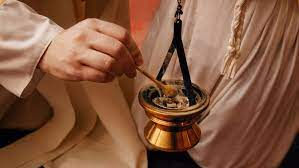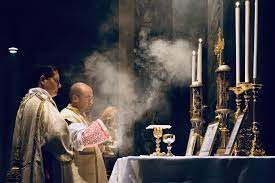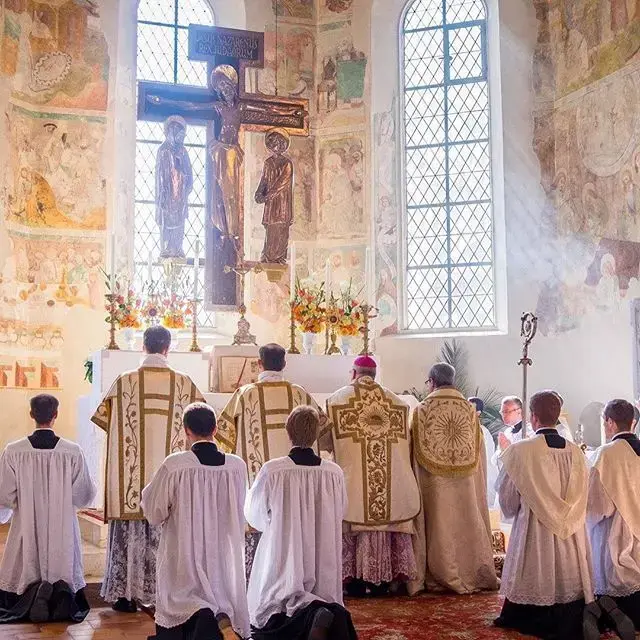Incense
- Father Matthew Schreiner
- Jun 27, 2023
- 8 min read
What is incense? What is it's significance?

What is incense. Incense is commonly used during masses, usually masses on special occasions. It is used in many different religions. It is very common in Asia, especially East Asia. It is also used by mostly Catholic Churches, Eastern Orthodox, Roman Catholics, and others. Incense dates back to Ancient Egyptian times, but it can probably find it's origins before than. Incense is burning different substances for their smell. Some of the most common Incenses used at churches in Frankencense (which is one of the Gift's presented to Jesus by the Magi).

What is Incense? Incense has many different types, but in the simply it is plant matter any kind, which is burned for its aroma. Burning incense has been an important ritual since ancient times.

Considered to have originated in Egypt, it was used by priests to cleanse tombs (especially of bad odor). Incense has a history of being used in ceremonies, rituals, and spiritual or religious occasions. The Burning of Incense was comeupon in India and South Asia in as early as 3300 BC. Used along with prayer and worship services. It was thought that incense burning could thwart demonic spirits and purify surroundings. More than 2,000 years ago, trade of incense played a significant economic role between the east and west. The Middle Eastern Incense Route went through the Middle East to the Mediterranean region, where it become popular because if the Roman

Empire. It’s estimated that 3,000 tons of incense traveled this route yearly. The spiritual role of burning incense varies based on the religion, ceremony, and or intention. Catholic churches typically burn frankincense to connect its community to the Jesus and the gift of Frankincense he received from the magi. Palo santo wood was burned during the height of the Incas to clear bad energy. Today, burning incense is synonymous with the practices of many religions, including Catholicism, Buddhism, and Hinduism, but uses go beyond the spiritual, as it is now common in places like yoga studios and our own homes. While burning incense may vary wildly in form, the essential function of it is to burn over time. Essentially it becomes smoldering ember which will slowly burn and release its aromatic compounds. It is also shown to have many health benefits. (https://seawitchbotanicals.com/pages/incense-use-history-health#:~:text=Believed%20to%20have%20originated%20in,as%20early%20as%203300%20BC.)

History of Incense in the Catholic Church

The word “incense” comes from the Latin "incendere", meaning “to burn”. Commonly used as a noun to describe aromatic matter that releases fragrant smoke when ignited, to describe the smoke itself, and as a verb to describe the process of distributing the smoke. Incense was a highly valuable in ancient times. A gift of incense was prized. The trading of incense provided economic basis for the 1,500-mile-long Middle Eastern Incense Route.

The use of incense in religious worship predates Christianity by thousands of years. First in the East, and later in the West, incense use has long been an important part of religious celebrations. Incense is noted in the Talmud, and the Bible mentions incense 170 times. The use of incense in Jewish temple worship continued well after the establishment of Christianity and certainly influenced the Catholic Church’s use of incense in liturgical celebrations.

The earliest documented history of using incense during a Catholic sacrificial liturgy comes from the Eastern branch of the Church. The rituals of the Divine Liturgies of Saint James and Saint Mark dating from the 5th century include the use of incense. In the Western Church, the 7th century Ordo Romanus VIII of mentions the use of incense during the procession of a bishop to the altar on Good Friday.

Documented history of incensing the Evangeliary (Book of Gospels) during the Mass dates from the 11th century. The use of incense within the liturgies continued to be developed over many years into what we are familiar with today. In the Old Testament God commanded His people to burn incense (e.g., Exodus 30:7, 40:27, inter alia). Incense is a sacramental used to venerate, bless, and sanctify. Its smoke conveys a sense of mystery and awe. It is a reminder of the sweet-smelling presence of our Lord. Its use adds a feeling of solemnity to the Mass. The visual imagery of the smoke and the smell reinforce the transcendence of the Mass linking Heaven with Earth, allowing us to enter into the presence of God. The smoke symbolizes the burning zeal of faith that should consume all Christians, while the fragrance symbolizes Christian virtue. Incensing may also be viewed in the context of a “burnt offering” given to God. In the Old Testament animal offerings were partially or wholly consumed by fire. In essence, to burn something was to give it to God.

In his monograph Sacred Signs, Monsignor Romano Guardini (1885-1968), who greatly influenced the writings of Pope Benedict XVI, had these beautiful words to say about the use of incense "The offering of an incense is a generous and beautiful rite. The bright grains of incense are laid upon the red-hot charcoal, the censer is swung, and the fragrant smoke rises in clouds. In the rhythm and the sweetness there is a musical quality; and like music also is the entire lack of practical utility: it is a prodigal waste of precious material. It is a pouring out of unwithholding love." (Sacred Signs, English translation, 1956 St. Louis, Pio Decimo Press. (ewtn.com/library/liturgy/sacrsign.txt))

Incense and the smoke of burning incense have been offered as gifts to God and to others since ancient times. In a more practical visual sense as the fragrant smoke ascends it also symbolizes our prayers rising to heaven.

The General Instruction of the Roman Missal (GIRM) has this to say about the use of incense: "§ 75 The bread and wine are placed on the altar by the priest to the accompaniment of the prescribed formulas. The priest may incense the gifts placed upon the altar and then incense the cross and the altar itself, so as to signify the Church’s offering and prayer rising like incense in the sight of God. Next, the priest, because of his sacred ministry, and the people, by reason of their baptismal dignity, may be incensed by the deacon or another minister."
Monsignor Guardini also had this beautiful thought about the use of incense within the Mass:

"The offering of incense is like Mary’s anointing (of Jesus) at Bethany. It is as free and objectless as beauty. It burns and is consumed like love that lasts through death. And the arid soul still takes his stand and asks the same question: What is the good of it? It is the offering of a sweet savor which Scripture itself tells us is the prayers of the Saints. Incense is the symbol of prayer. Like pure prayer it has in view no object of its own; it asks nothing for itself. It rises like the Gloria at the end of a psalm in adoration and thanksgiving to God for his great glory." (Sacred Signs)

Incense smoke symbolically purifies all that it touches. This is best illustrated by the richly symbolic practice in the Chaldean Rite of the Catholic Church. Those preparing to receive Holy Communion during the Holy Qurbono (Chaldean sacrificial liturgy) first purify their hands by holding them in smoke just above a bowl of burning incense. Similarly in the Maronite Rite of the Catholic Church, as they are being purified prior to liturgical use, the liturgical vessels — chalice, diskos (similar to the paten), and its asterisk (star) cover — are all inverted over the burning incense to catch the fragrant smoke.

How is incense used in the Mass? The GIRM provides instruction for the use of incense during the celebration of the Mass as follows:
"§ 277 The priest, having put incense into the thurible, blesses it with the sign of the Cross, without saying anything. Before and after an incensation, a profound bow is made to the person or object that is incensed, except for the incensation of the altar and the offerings for the Sacrifice of the Mass. Three swings of the thurible are used to incense: the Most Blessed Sacrament, a relic of the Holy Cross and images of the Lord exposed for public veneration, the offerings for the Sacrifice of the Mass, the altar cross, the Book of the Gospels, the paschal candle, the Priest, and the people. Two swings of the thurible are used to incense relics and images of the Saints exposed for public veneration; this should be done, however, only at the beginning of the celebration, following the incensation of the altar. ..." Where is incense used in the Mass?

Similarly, GIRM 276 allows for the use of incense at the following times during the celebration of Mass: "§ 276 Thurification or incensation is an expression of reverence and of prayer, as is signified in Sacred Scripture (cf. Ps 141 [140]:2; Rev 8:3). Incense may be used optionally in any form of Mass:
a) during the Entrance Procession;
b) at the beginning of Mass, to incense the cross and the altar;
c) at the procession before the Gospel and the proclamation of the Gospel itself;
d) after the bread and the chalice have been placed on the altar, to incense the offerings, the cross, and the altar, as well as the Priest and the people;
e) at the elevation of the host and the chalice after the Consecration.
Incense is also used on Holy Thursday, during the procession with the Blessed Sacrament to the altar of repose." At the Easter Vigil, five grains of encapsulated incense (most often made to look like red nails) are embedded in the paschal candle. These five grains of incense represent the five wounds of Jesus Christ — one in each hand, one in each foot, and the spear thrust into His side. At funeral Masses the earthly remains of the decedent and the catafalque may be incensed, and also the gravesite at the burial service.

Use of incense outside of the Mass. Incense is used by the Church in many areas outside of the Mass. Near the end of the 4th century, the pilgrim Etheria (Silvia) witnessed use of incense at the vigil Office of the Sunday in Jerusalem. Many individuals today include the burning of incense as part of their praying of the Liturgy of the Hours or during private prayers of their own formulation. The Roman Ordos from the 7th to the 14th centuries document the use of incense at the Gospel reading, at the Offertory, and Benediction of the Blessed Sacrament. Incense is used in various solemn processions, graveside services, the blessing of the dedication of new churches, cemeteries, and items such as new altars, new church bells, new sacred vessels, and newly acquired copies of the Book of Gospels.

Incense is also used in the rite of consecrating of the chrism and the blessing of other holy oils, and during the singing of the Gospel canticle at solemn Morning and Evening Prayers of the Divine Office. Grains of incense are placed into the sepulcher of newly consecrated altars along with the relics of saints to represent the burial rite of the ancient martyrs and to symbolize the prayers of the saint to whom the relic belongs. Incense is burned atop new altars as they are undergoing the process of consecration prior to their first use.

Finally, frankincense and myrrh are often blessed at the Mass of the Feast of the Epiphany to commemorate the visitation of the Biblical Magi to the Baby Jesus. This incense is distributed to attendees for use at their own family altars and to reserve for use at the coming Easter to prepare their home paschal candles.
The Catholic faith is a liturgical faith. It makes use of all five of our senses: sight, sound, smell, taste, and touch. This is certainly by design as each sense aids us in availing ourselves of the salvific grace flowing from the Holy Sacrifice of the Mass. This is precisely why every effort should be used to employ all of our senses whenever possible during the celebration of the sacred liturgy. In more concise terms, the “smells and bells” most certainly do matter.
(https://adoremus.org/2012/02/holy-smoke-the-use-of-incense-in-the-catholic-church/#:~:text=The%20earliest%20documented%20history%20of,include%20the%20use%20of%20incense.)



There are many different types of incense for example Cones, Sticks, Charcoal/Resin, and many more. The most common kid used in the Catholic Church is Resin, and the most common fragrence is Frankincense, which was the type that was given to Jesus by the Magi. Around Christmas Time our family uses Incense stikes in tiny houses, similiar to incense cones. All types of incense have there own importance, and distinct smell. They are all important in there own ways.
Incense is an important part of sacredness, and can help make a place feel more sacred and religious. If you would like to purchase incense for use at your house there are many kits you can buy from, and many places. You do not have to be a minister to use incense. The smell is terrific and can help you feel more Holy and help with prayer.

Father Matthew Schreiner

Kosciol Church


Comments